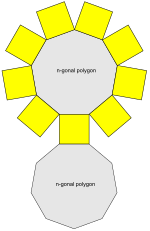Prism (geometry)
Appearance
| Set of uniform prisms | |
|---|---|
 (A hexagonal prism is shown) | |
| Type | uniform polyhedron |
| Faces | 2+n total: 2 {n} n {4} |
| Edges | 3n |
| Vertices | 2n |
| Schläfli symbol | {n}×{} or t{2, n} |
| Coxeter-Dynkin diagram | |
| Vertex configuration | 4.4.n |
| Symmetry group | Dnh, [n,2], (*n22), order 4n |
| Rotation group | Dn, [n,2]+, (n22), order 2n |
| Dual polyhedron | bipyramids |
| Properties | convex, semi-regular vertex-transitive |
 n-gonal prism net (n = 9 here) | |
A prism is a three-dimensional shape, which is made of two polygons at each of its two ends. Each pair of polygon sides on the same axis will have a quadrilateral (four-sided shape) face between them.
There are an infinite number of different prisms, which can be based on a polygon with any number of sides.
A cube is a special kind of prism with squares for the faces on its ends and for the faces between them.




























